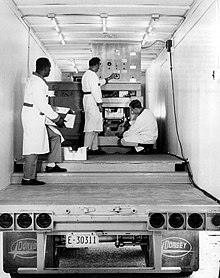
Back تشعيع الأغذية Arabic Апраменьванне харчовых прадуктаў Byelorussian Лъчева стерилизация на хранителни продукти Bulgarian Irradiació dels aliments Catalan Lebensmittelbestrahlung German Irradiación de alimentos Spanish پرتودهی خوراک Persian Elintarvikkeiden säteilyttäminen Finnish Irradiation des aliments French Ionradú bia Irish


Food irradiation (sometimes radurization or radurisation) is the process of exposing food and food packaging to ionizing radiation, such as from gamma rays, x-rays, or electron beams.[1][2][3] Food irradiation improves food safety and extends product shelf life (preservation) by effectively destroying organisms responsible for spoilage and foodborne illness, inhibits sprouting or ripening, and is a means of controlling insects and invasive pests.[1][3]
In the US, consumer perception of foods treated with irradiation is more negative than those processed by other means.[4] The U.S. Food and Drug Administration (FDA), the World Health Organization (WHO), the Centers for Disease Control and Prevention (CDC), and U.S. Department of Agriculture (USDA) have performed studies that confirm irradiation to be safe.[1][5][6][7][8] In order for a food to be irradiated in the US, the FDA will still require that the specific food be thoroughly tested for irradiation safety.[9]
Food irradiation is permitted in over 60 countries, and about 500,000 metric tons of food are processed annually worldwide.[10] The regulations for how food is to be irradiated, as well as the foods allowed to be irradiated, vary greatly from country to country. In Austria, Germany, and many other countries of the European Union only dried herbs, spices, and seasonings can be processed with irradiation and only at a specific dose, while in Brazil all foods are allowed at any dose.[11][12][13][14][15]
- ^ a b c "Food irradiation: What you need to know". US Food and Drug Administration. January 4, 2018. Archived from the original on September 27, 2020. Retrieved October 5, 2020.
- ^ WHO (1988). Food Irradiation: A technique for preserving and improving the safety of food. Geneva, Switzerland: World Health Organization. hdl:10665/38544. ISBN 978-924-154240-1. Archived from the original on October 19, 2020. Retrieved October 5, 2020.
- ^ a b "Food irradiation". Canadian Food Inspection Agency. October 31, 2016. Archived from the original on February 1, 2016. Retrieved October 5, 2020.
- ^ Conley, Susan Templin (Fall 1992). "What Do Consumers Think About Irradiated Foods?". FSIS Food Safety Review. 2 (3): 11–15. Archived from the original on September 22, 2023. Retrieved March 15, 2020.
- ^ Cite error: The named reference
JFDiehlwas invoked but never defined (see the help page). - ^ Cite error: The named reference
JSGHDIwas invoked but never defined (see the help page). - ^ World Health Organization. Safety and Nutritional Adequacy of Irradiated Food. Geneva, Switzerland: World Health Organization; 1994
- ^ Cite error: The named reference
FDA1986was invoked but never defined (see the help page). - ^ "The FDA's position on irradiation". Food and Drug Administration. Archived from the original on April 23, 2019. Retrieved March 8, 2019.
- ^ "Irradiation testing for correct labelling you can trust". Eurofins Scientific. January 2015. Archived from the original on April 8, 2016. Retrieved February 9, 2015.
- ^ "Food Irradiation Clearances". Nucleus.iaea.org. Archived from the original on October 17, 2012. Retrieved March 19, 2014.
- ^ "Food irradiation, Position of ADA". J Am Diet Assoc. Archived from the original on February 16, 2016. Retrieved February 5, 2016. retrieved November 15, 2007
- ^ Deeley, C.M.; Gao, M.; Hunter, R.; Ehlermann, D.A.E. (2006). Food Tutorial — The development of food irradiation in the Asia Pacific, the Americas and Europe. International Meeting on Radiation Processing. Kuala Lumpur. Archived from the original on July 26, 2011. Retrieved February 18, 2010.
- ^ Kume, Tamikazu; Furuta, Masakazu; Todoriki, Setsuko; Uenoyama, Naoki; Kobayashi, Yasuhiko (March 2009). "Status of food irradiation in the world". Radiation Physics and Chemistry. 78 (3): 222–226. Bibcode:2009RaPC...78..222K. doi:10.1016/j.radphyschem.2008.09.009.
- ^ Farkas, József; Mohácsi-Farkas, Csilla (March 2011). "History and future of food irradiation". Trends in Food Science & Technology. 22 (2–3): 121–126. doi:10.1016/j.tifs.2010.04.002.
© MMXXIII Rich X Search. We shall prevail. All rights reserved. Rich X Search